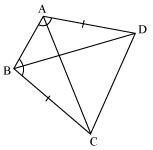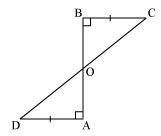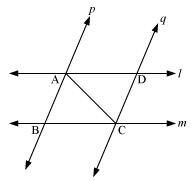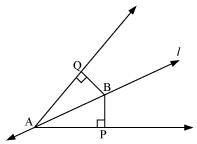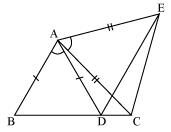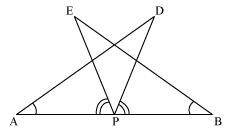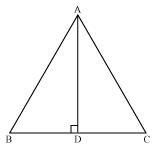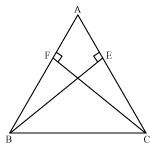ΔABC and ΔDBC are two isosceles triangles on the same base BC and vertices A and D are on the same side of BC (see the given figure). If AD is extended to intersect BC at P, show that
(i) ΔABD ≅ ΔACD
(ii) ΔABP ≅ ΔACP
(iii) AP bisects ∠A as well as ∠D.
(iv) AP is the perpendicular bisector of BC.

(i) In ΔABD and ΔACD,
AB = AC (Given)
BD = CD (Given)
AD = AD (Common)
∴ ΔABD ≅ ΔACD (By SSS congruence rule)
⇒ ∠BAD = ∠CAD (By CPCT)
⇒ ∠BAP = ∠CAP …. (1)
(ii) In ΔABP and ΔACP,
AB = AC (Given)
∠BAP = ∠CAP [From equation (1)]
AP = AP (Common)
∴ ΔABP ≅ ΔACP (By SAS congruence rule)
⇒ BP = CP (By CPCT) … (2)
(iii) From equation (1),
∠BAP = ∠CAP
Hence, AP bisects ∠A.
In ΔBDP and ΔCDP,
BD = CD (Given)
DP = DP (Common)
BP = CP [From equation (2)]
∴ ΔBDP ≅ ΔCDP (By S.S.S. Congruence rule)
⇒ ∠BDP = ∠CDP (By CPCT) … (3)
Hence, AP bisects ∠D.
(iv) ΔBDP ≅ ΔCDP
∴ ∠BPD = ∠CPD (By CPCT) …. (4)
∠BPD + ∠CPD = 180 (Linear pair angles)
∠BPD + ∠BPD = 180
2∠BPD = 180 [From equation (4)]
∠BPD = 90 … (5)
From equations (2) and (5), it can be said that AP is the perpendicular bisector of BC.




